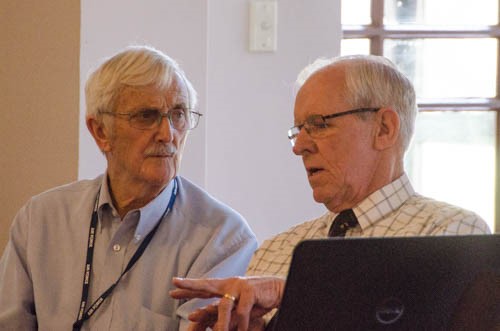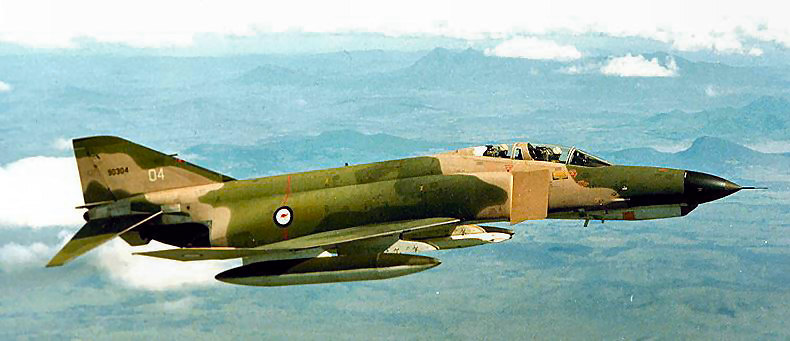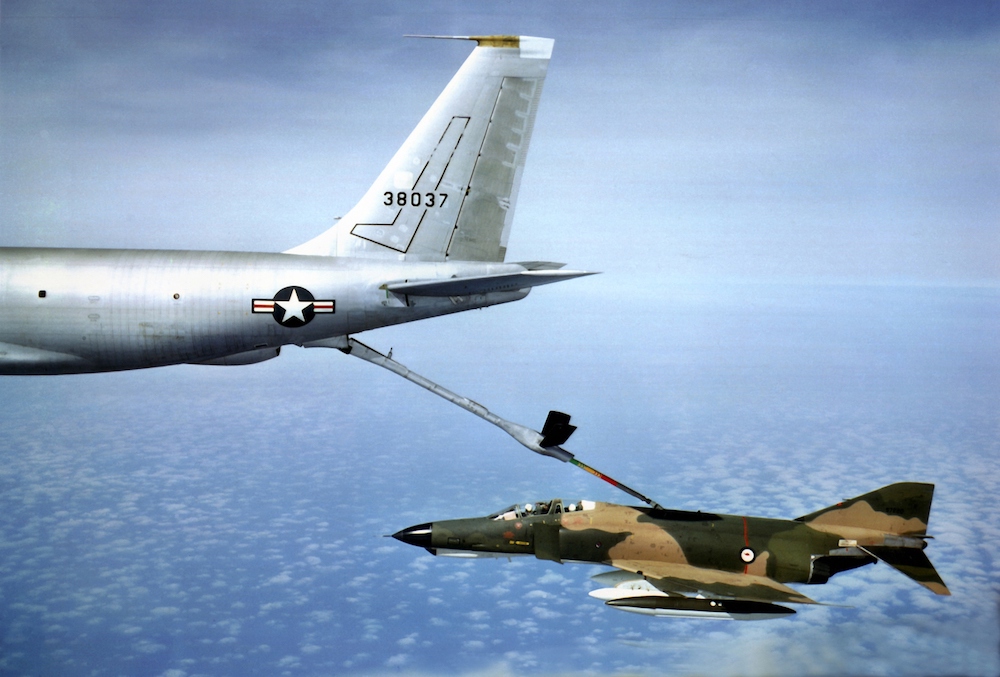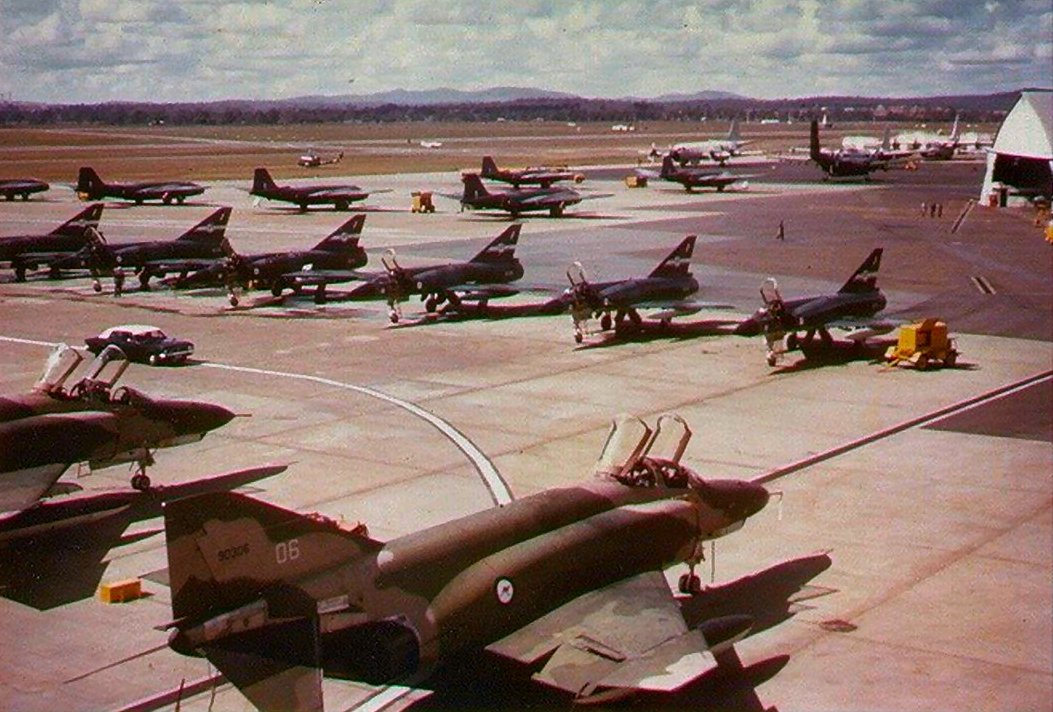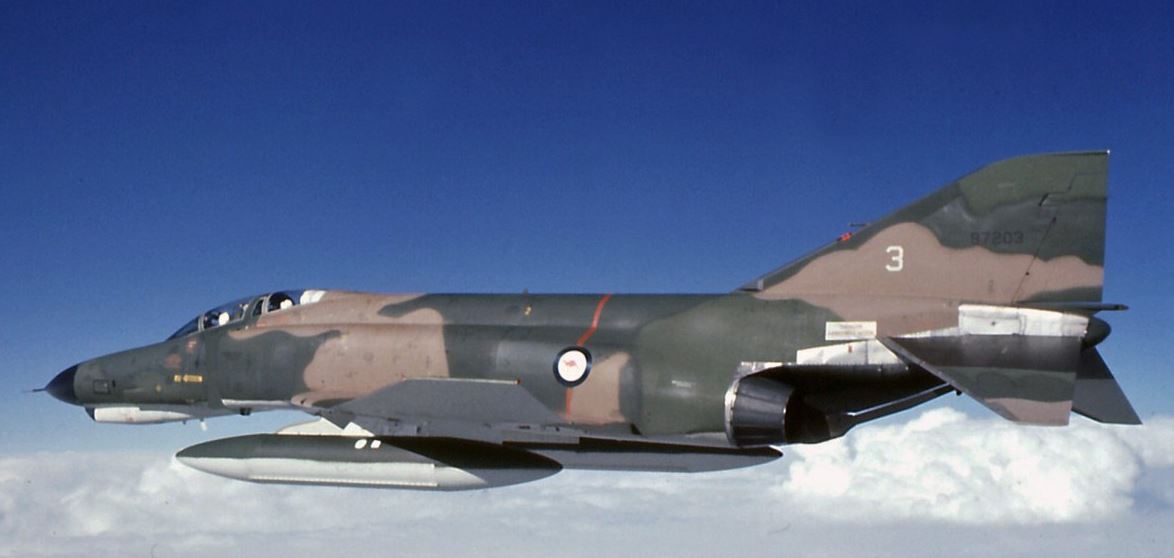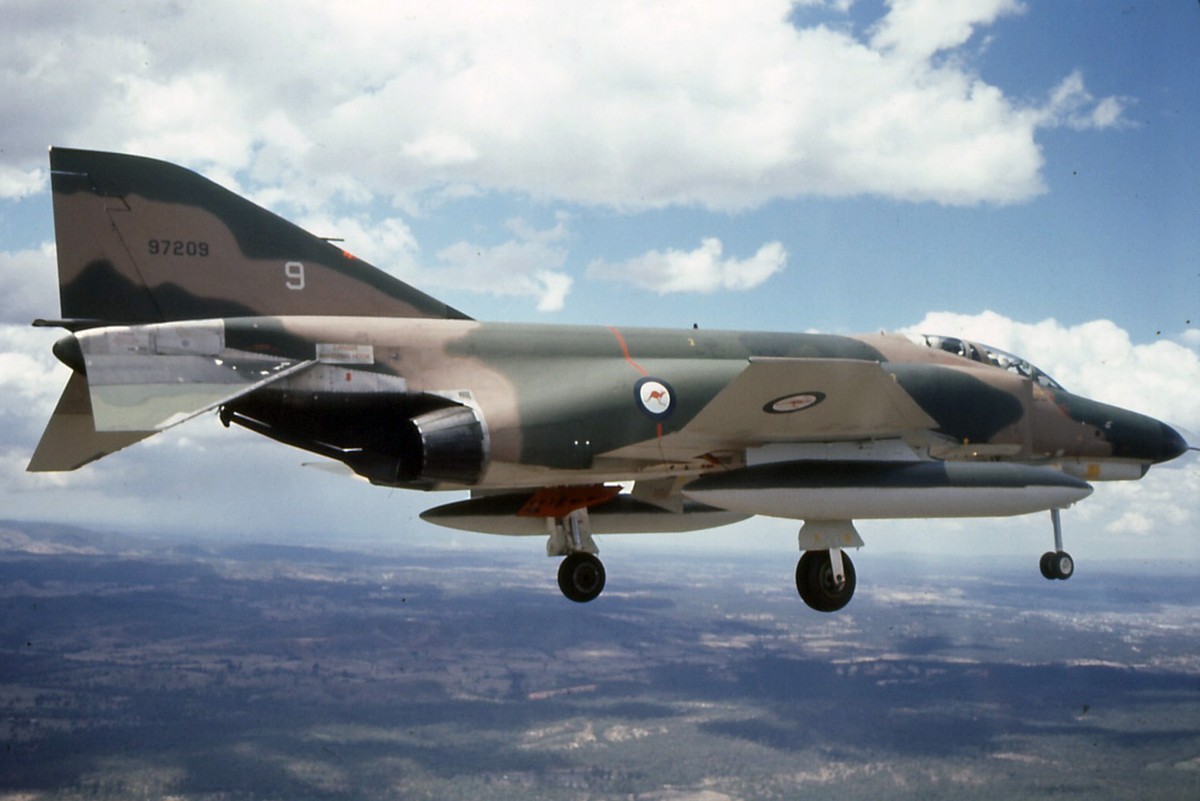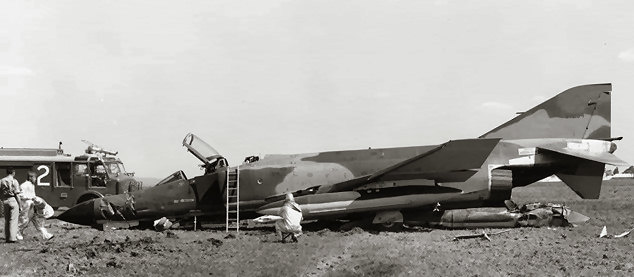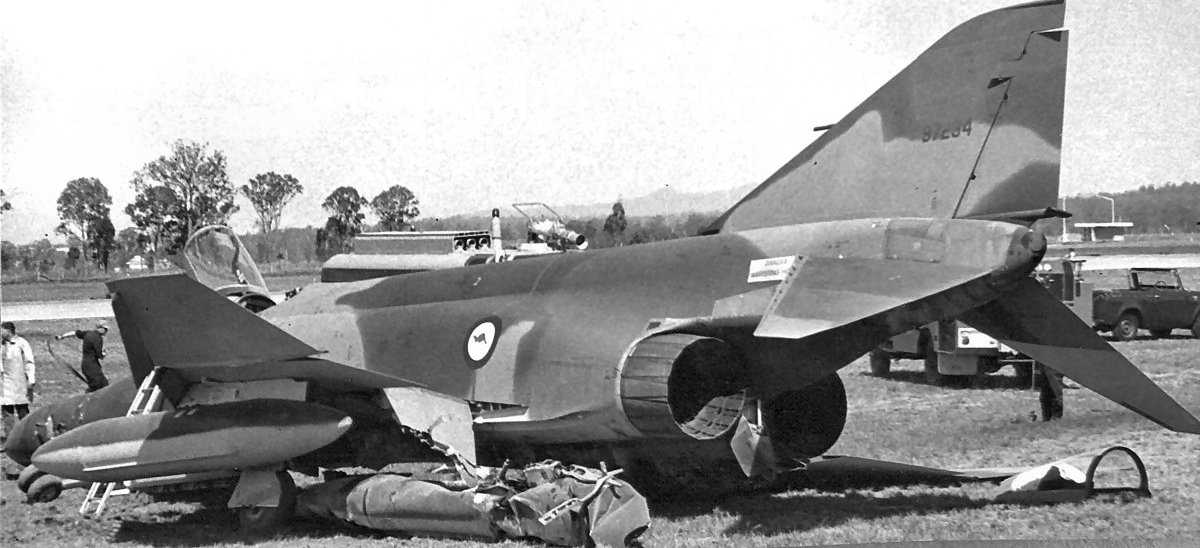|
|
||
|
||
|
Privacy Policy | Editorial Policy | Profit Policy | Join the Association | List of Members | Contact us | Index | Links |
||
|
Back Go to page: 1 2 3 4 5 6 7 8 9 10 11 12 13 14 15 16 17 18 19 20 Forward |
||
|
|
||
|
My Story |
||
|
|
||
|
Phantom F-4E in RAAF service.
Lance Halvorson and Dave Rogers AM
In October 1963 the Australian government announced the purchase of the then untested General Dynamics F-111. The aircraft ordered were due for delivery in 1968 to replace the RAAF's fleet of Government Aircraft Factory built English Electric Canberra bombers, however by 1969 continuing problems with the F-111 programme and a possible delivery date of 1974, if at all, meant an interim type was required as the Canberra's were running out of airframe hours.
|
||
|
|
||
|
Lance Halvorson and Dave Rogers AM
|
||
|
Background.
Defence Minister Fraser led a team of RAAF specialists to USA to review the F111 program with US officials. US Defence Secretary Laird was keen that Australia could meet its strategic interests in South East Asia and offered the F4E Phantoms as interim strike aircraft, at short notice and on very favourable terms. A little known feature of the agreement was that under U.S law, leased equipment could be recalled on the basis of...."extraordinary contractual actions to facilitate the national defence"....ie: the U.S could demand the return of the Phantom's at any time! The agreement also contained an option for Australia to buy the F-4's at US$12 Million each, should the F-111 program be cancelled. |
||
|
|
||
|
While the F4E was a great combat aircraft of the 1960s, it was an all-weather fighter with a limited all-weather ground attack capability. In the strike/attack roles, it could carry 12 x 500lb (227Kg) bombs and up to 4 Sidewinder air-to-air missiles, unrefuelled, over a combat radius of 450 n miles (840Km). Air-to-air refuelling would extend this radius. The Deputy Chief of Air Staff (DCAS) at the time, Air Vice-Marshal Charles Read, recommended the F4-E Phantom over two alternatives, the Grumman A-6 Intruder, a capable all-weather attack aircraft and the British Buccaneer.
Interestingly, the F111 had a Navigation Bombing System (NBS) with similar capabilities to that installed in the A-6 aircraft. While the F4-E had a Weapons Release Computer System (WRCS) and the Buccaneer had a basic weapons delivery system, neither had a weapons system comparable to the F111 or the A-6. US technology, together with a proven combat record and weapons delivery platform (albeit visual), were better indicators of the RAAF preference for the F4-E while awaiting the F111 deliveries.
The McDonnell Douglas PHANTOM II was the fighter aircraft of the 1960s and 1970s. Designed as a fighter aircraft for the US Navy, it was used in many roles: fighter, interceptor, fighter-bomber, reconnaissance, tanker, drone, defence suppression and laser designator aircraft. The F-4 was the mainstay of the Western Alliance air forces and during the Vietnam War it meant American airpower. A total of 5,195 Phantoms were built in seventeen major variants. The RAAF operated the F4E as an interim aircraft while awaiting delivery of the F111C from 1970-1973.
From a pilot perspective, the F-4E was a magnificent aircraft to fly and operate. The high thrust-weight ratio, (with the great afterburners), gave excellent acceleration and the 8.5g limit, (clean) multiple/heavy weapons loads and integrated air-to-air and air-to-ground radar/navigation systems, made the aircraft a formidable weapons platform. Those of us who were fortunate to have flown and maintained the Phantom F4E in Nos 1 and 6 Squadrons, RAAF, remember those years with pride and satisfaction of having flown one of the world's great fighters. The F4 is the leading aircraft in the Warplane Hall of Fame.
Fraser-Laird Agreement.
In June 1970 the Australian government announced the unusual step of leasing twenty four new Mc Donnell Douglas F-4E Phantom II's at a cost of US$34 Million over a two year period inclusive of spares and training. The aircraft were delivered from the McDonnell factory in St Louis. Air-to-air refuelling support was included in the agreement; subject to a US overriding requirement, USAF would provide in-flight refuelling if a defence emergency requirement arose where Australia needed to deploy the Phantoms. Air-to-air refuelling was essential, as the F4-E was limited in range and could not deploy far outside Australia without tanker support.
|
||
|
|
||
|
Training and Ferry.
Preparation for the receipt of the Phantom commenced in July 1970 with 39 members of a USAF Maintenance Training Team arriving at RAAF Amberley. A further 20 members of a USAF Maintenance Advisory Team and Mc Donnell Douglas representative Mr Arthur Hyde arrived in Australia in August 1970. Aircrew training commenced in July 1970 at the McDill AFB in Tampa, Florida with navigators undergoing some initial systems work at Davis Monthan AFB in Tuscon, Arizona for a few weeks. Personnel of 1 and 6 Squadron's (82 Wing) RAAF who were tasked with operating the Phantom completed their conversion to type by September 1970.
Many aircrew and ground crew selected for the F4-E project had completed training on the F-111 in 1968 and were conversant with modern weapons systems. The first crews left Australia in early July 1970. Of the original 24 navigators who trained on the F111A at Nellis AFB in 1968, only ten remained at 82Wing. They were the first to depart for USA to train on the weapons system. Navigators who trained at Davis Monthan, joined the pilots in August for flight conversion to the aircraft. Following conversion, crews picked up new F4-Es at the McDonnell Douglas factory before ferrying the aircraft to Amberley, via George AFB, Ca, Hickam AFB, Hi and Andersen AFB, Guam.
A mix of USAF and RAAF crews completed the ferry, with the last two Phantoms reaching Amberley on 4 October 1970. Captain Chris Patterakis (USAF) and FLTLT Lance Halvorson crewed the second last aircraft to reach Australia.
|
||
|
Back Home.
By the end of November 1970, the RAAF had two squadrons of Phantoms operating at Amberley with minimal USAF support. Much of the ground support equipment procured for the F-111 was used and a limited amount of test equipment came as part of the package. The project indicated the professional competence of the RAAF to train on a new aircraft, ferry the aircraft over the Pacific and have two squadrons operational in Australia six months after the decision was made to lease the F4-E Phantom.
The Phantoms were immediate hits with air and maintenance crews and the Australian public. During the RAAF`s 50th Anniversary celebrations in March 1971, the Phantoms were the crowd pullers at major air shows in seven states. From a pilot perspective, the F-4E was great to fly and operate. The high thrust-weight ratio, (with great afterburners and the GE J79 engine), gave excellent acceleration and the 8.5g limit, multiple/heavy weapons loads and integrated air-to-air and air-to-ground radar/nav systems, were major technology leaps for crews who were used to the basic systems in the Canberra and Sabre. As in all two-crew aircraft, teamwork between the pilot and navigator in the planning and air phases of a mission is the key to success. Management of the weapons systems was a continual challenge to improve weapons delivery accuracy and post flight analysis by air and ground crews paid dividends. The serviceability rates achieved by the RAAF far exceeded that of many similar USAF units.
At that time, the F4-E model was the leading fighter in the west. It was a solid, stable weapons launch platform, yet highly agile given the aerodynamic design and dependable GE engines. Full afterburner to idle and back to full military power produced no stalls or other adverse effects, a trait not seen on many engines at that time. With a clean aircraft and 12500lb (5700Kg) fuel, from brakes off to 600 knots took a little under 40 seconds and a 3-4g rotation and climb to 40,000 feet took another minute. Perhaps slow by some of the aircraft today, but incredible in the 1960-1970s. |
||
|
|
||
|
Air to ground gunnery with the nose-mounted GE M61 Vulcan 20mm gun was a new experience to many. A typical pattern was to enter at 4000 feet, followed by a low angle (15 degree) descent, opening fire at 1800 feet and cease firing at 1200 feet slant range. A yaw string on the nose in front of the pilot, assisted in balancing the aircraft for weapons release or gun firing. The gun had 6000 rounds per minute rate of fire, with a rounds limiter switch, which reduced the number of rounds, to about 254, each time gun trigger was depressed. Rate of fire could be reduced to about 4500.
Crews used all the bombing modes, including, dive, skip, dive toss and level radar but the most accurate was the dive-toss—the navigator would acquire a radar lock on ground return, which provided slant range to the weapons computer to calculate the release point as the pilot tracked the target with the pipper. The weapon was released automatically as the pilot initiated a 4g dive pullout.
The RAAF used the Phantom primarily in the strike role although most sorties included training in the air-to-air role. Crews practised visual dive bombing from 30-60 degree (max 30 degree at night was exciting). The F-4E did not have an all-weather strike capability as the F-111 had. It suffered from an adverse yaw problem - at high angles of attack when aileron was applied, the aircraft would turn the opposite direction and depart controlled flight. The solution was to use rudder only, which took a bit of getting used to. In a tight turn about 5-6g, to reverse the turn, it was a boot full of top (or bottom, depending on the circumstances) rudder and hold the back stick. The aircraft would really whip around, so crews had to be on their toes.
Pilot induced oscillations (PIOs) could be a problem—caused by control inputs out of synchronisation with aircraft movements; a vicious un-planned change of flight direction was the result. Excessive power changes resulted in rapid trim changes with similar results.
|
||
|
|
||
|
Landing the Phantom was like any other Century series aircraft. Normal practice was to maintain speed around 125-130KIAS and fly at a constant angle of attack, no round out, until touchdown. Boundary layer control (BLC) improved the low speed handling of the aircraft. Ground effect and rounding out did flatten the approach slightly. The drag chute was very effective and often pilots would need power to make the turnoff before dropping the chute; nose wheel steering was engaged at 70KIAS. The E model brakes were very effective and with good judgement, the aircraft could easily stop in 1500 feet.
Landing Accident.
A cruel twist of fate involved A69-34 on her very first flight out of Amberley after delivery from the USA. On October 19th, 1970, FLT LT Jack Ellis and SQN LDR Brian Bolger experienced a generator and bus tie contactor failure. This meant a loss of nose-wheel steering and anti-skid brakes together with a few other control systems. With a strong crosswind at Amberley, Ellis wisely elected to engage the arrestor cable for recovery. Unfortunately, the cable snapped on engagement and the huge shock absorber was dragged through the hook, breaking it off but also imparting a turning and nose rearing component to the flight path. The aircraft came back on the runway with about 30 degrees of drift, then proceeded to slide off the sealed surface sideways, ground looped during which the right main gear and the nose-wheel collapsed. When the aircraft came to a stop, Bolger blew the rear canopy off and exited, while Ellis, opened his and followed rapidly. They both suffered only minor, superficial injuries.
The damage assessment indicated that the aircraft would have to be returned to the factory for repair but RAAF engineers had other ideas. Over the next 350 odd days, they constructed jigs, removed the damaged components and did a first class job of repairing her to better than new condition. SQN LDR Ken Smith and FLT LT Frank Burtt did the test flight and cleared her to return to the line without a snag. The task was a credit to the RAAF engineers involved as the USAF said it could not be done!.
|
||
|
|
||
|
|
||
|
Loss of A69-03.
The occupational hazards of flying high performance aircraft in hazardous conditions was brought home to the RAAF Phantom community when the RAAF lost an F4-E and crew on the night of 16 June 1971 near the Evans Head bombing range in NSW. After taking off from Amberley at 18:13 hours and following a bombing run at the Evans Head range, in inclement weather, the aircraft was clearing the range to the north and was completing a visual re-join on the flight lead when radio contact was lost. The following day after an extensive search had been initiated using military and civilian aircraft and shipping, pieces of wreckage were recovered and the aircraft officially identified as that of the missing Phantom.
The aircraft had crashed into the sea off Evans Head with the loss of her experienced crew, Pilot SQNLDR Stu Fisher and navigator FLTLT Rob Waring. Stu Fisher was a qualified Test Pilot and Instructor, whilst Rob Waring was a 2 Sqn, RAAF Vietnam (April 1967 – Oct 1967) veteran.
You can read the report on the accident HERE.
|
||
|
Return to USA.
On the 25th October 1972 six RAAF Phantom's returned to the United States followed by five more in November 1972, then another six in June 1973 and another four in June 1973. Finally in June,1973 the last two Phantom's departed for their US home, all flown by USAF crews from the 388th Fighter Wing (388FW). The USAF had positioned a number of KC135 tankers at Amberley for refuelling duties on the return leg.
After only 2 years 9 months and 3 days the Phantom's RAAF tour of duty was complete.
Most of the 23 Phantoms returned to USA were modified to F-4G Wild Weasel
(electronic warfare) aircraft and continued flying until the USAF retired the
type in the late 90s. Nearly all the remaining ex-RAAF tail numbers were
modified to QF-4 drones and employed as targets or are stored at AMARC
(boneyard) at Davis Monthan AFB, Arizona.
The last official RAAF Phantom flight was on the 20th June 1973 with Pilot SQNLDR Dave Rogers (right) and Navigator FLTLT Lester Cavanagh. The aircraft was A69-8.
At the time of the Phantom's arrival RAAF members were brimming with enthusiasm to fly the F-4E, as the troubled F-111 was some years away. The prospect of a ground job or flying the Canberra for 8-10 hours a month on unproductive tasks was an unpalatable alternate. The Phantom was much more than a giant step ahead of the Canberra's in RAAF service and provided great experience leading into the introduction of the F-111. The USAF did offer the remaining 23 F-4E's to the RAAF for AUD$54 Million, however this did not include spares and ground handling equipment, items which had not been procured due to the lease deal. However the deal with General Dynamics for the then still troubled F-111 was binding and the procurement went ahead.
Maintenance.
In the short service life of the F-4E in the RAAF, several modifications were carried out. These included changes to the Westinghouse APQ-120 radar (completed June 1971), a check of all aircraft for defects in the flap emergency system (September 1971) with four aircraft having loose or broken lines. The most obvious modification to the RAAF Phantom fleet was the addition of low voltage formation strip lighting on the fuselage, vertical fin and wing tips, plus the "Midas 4" gun blast diffuser. The "Midas 4" mod was an extension to the aircraft nose cannon which allowed gun gas to be dispersed to stop engine flameout and a loud whistle, which could be heard from approaching F-4E's. Furthermore, some Phantom's required X-rays in early 1972, after the discovery of a large crack in the stabilators of 69-7234 "34" and it was discovered 69-7209 "09" was similarly affected.
F-111 maintenance bods after they had finished the acceptance on the first F-111.
Summary.
The RAAF crews who were fortunate to have been involved with the Phantom in RAAF service remember the years with pride and satisfaction of having flown one of the world’s great fighters. The aircraft certainly introduced the RAAF into the American way of the fast, high technology fighter/bomber with advanced systems, however, it did not have the capability that the RAAF required in an all-weather strike aircraft that the F111 would provide from June 1973.
While here, the major defence exercises in which Phantoms took part included "Pepper Pot" (21/10/71 - 06/11/71) working out of RAAF Darwin, with 77Sqn Mirages . After the exercise in November 1971 two Phantom's flew in excess of 2,800 kms from RAAF Darwin to their homebase RAAF Amberley, non stop. Another exercise was "Top Limit" during May 1972 again in Darwin with the F-4s "attacking" Darwin which was defended by RAAF Mirages and then in October 1972 the Phantoms attacked a splash target towed by HMAS Duchess off the coast near Gladstone, Qld.
|
||
|
|
||
|
Back Go to page: 1 2 3 4 5 6 7 8 9 10 11 12 13 14 15 16 17 18 19 20 Forward |
||


